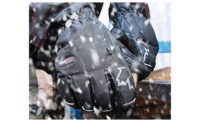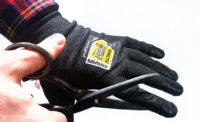Thanks to material innovation and technological advancements, the modern welding glove doesn’t have much in common with those from 30 years ago. These days, glove manufacturers have access to higher performing materials and better sewing patterns. But with so many options on the market, how do you know which ones are the best welding gloves for your application? Here are five questions you should ask yourself when choosing your next pair of welding gloves.
1. What type of welding will you be doing?
TIG welding is the best option when you’re looking for precision – like on a structural weld. If you are looking to create a clean, precise bead that needs little or no grinding or smoothing then choose this style of welding. These highly-technical welds work great for short runs and on a variety of metals including aluminum, stainless steel and zinc anneal.
MIG welding is great for high production. It can make the job quicker and easier if, for instance, you need to complete a long run (10 to 15 feet) of welding. MIG welding is also great for tacking pieces before completing the full weld. It doesn’t require as much clean up as stick welding and it can be used on thinner metal like car doors.
Stick welding, also known as Shielded Metal Arc Welding (SMAW), is one of the world’s first and most widely used welding processes. Unlike TIG and MIG welding, stick welding produces the most heat, sparks and spatter. Stick welding is a versatile process because it can be performed inside and outside and in remote areas. This makes it preferable for working on pipelines, refineries or ships.
2. What type of material is your glove made of?
Your welding gloves will almost certainly be leather. It’s the preferred material because of its high abrasion resistance, good heat properties and it won’t ignite. Different types of leather will have different properties; the two most popular leather for welding are goat and cow. Depending on the type of welding, here’s what you should consider:
Goat grain
- Great for TIG or MIG welding because of its durability and touch sensitivity
- It’s not too thin like sheepskin but not as thick as cow grain
- Considered to be economical, strong and durable
Cow grain
- Cow grain is the most common leather
- Excellent for high heat applications like stick welding
- Good for durability and comfort
3. Do you need Kevlar®?
In the glove world, Kevlar® is used for three main things:
- Cut resistance
- Seam stitching
- Heat resistance (covered in-depth in question five.)
Cut protection: Cuts and lacerations are common in every industry and it’s not unheard of to have sharp or jagged edges on the metal you’re welding. A Kevlar® liner in your welding glove will add cut resistance without adding bulk.
Seam stitching: The lifespan of a glove changes drastically depending on how much welding you do. Wear and tear to your glove is pretty common due to heat and abrasion when handling metal.
Kevlar® is an excellent alternative to your typical cotton yarn for stitching seams together because of its high-heat properties. Seams won’t split nearly as easily when Kevlar® thread.
4. Are UV rays a concern when welding?
Forget the “tough it out to toughen you up” rhetoric. You wouldn’t weld without a face mask, so why would you weld without a protective sleeve?
But arm coverage has more to do than just protecting you from sparks or slag. UV rays emitted from welding will affect your body the same way that staying out too long in the sun will. Weld arcs are so bright that they can lead to a condition called “arc eye,” if the proper precautions are not taken.
The Canadian Centre for Occupational Health and Safety identifies the risk of radiation and its effects on the skin: “UV radiation in a welding arc will burn unprotected skin just like UV radiation in sunlight. This is true for direct exposure to UV radiation as well as radiation that is reflected from metal surfaces, walls, and ceilings… Long-term exposure to UV radiation can cause skin cancer.”
Different types of welding will require different types of arm coverage.
MIG and TIG Welding: A string-knit sleeve made with Kevlar® will help to protect your skin both from UV rays and slag/spatter. The added bonus of using a string-knit sleeve is that it will allow for your skin to breathe, since overheating is a common concern when welding.
Stick Welding: Due to the heat produced during stick welding, you’ll require something a bit more heavy duty than a string-knit sleeve. Consider using a leather welder’s jacket which will protect your skin from spark and spatter while reducing your risk of burn or skin cancer.
5. What type of insulation should you use?
It doesn’t matter the type of welding – TIG, MIG or Stick – a lot of heat will be produced.
Not surprisingly, the metal you’re welding will be hot after running a line. The spark and heat being produced from the torch will also begin to heat up your hands. The amount of insulation you’ll require depends on the amount of heat that’s being produced.
Cotton liner: Cotton is a good insulator for moderate temperature – upwards of 450°F. It will add some bulk to your glove but it is a cost-effective option.
Kevlar® liner: When dexterity is needed, like TIG welding, a cotton liner may be too bulky. In these situations, a welder’s glove with a Kevlar® liner will help. Kevlar® has an good reputation for heat resistance and won’t drip or melt even at 800°F. It also won’t add noticeable bulk to the glove. The Kevlar® lining will give the glove cut resistance, which can be beneficial when dealing with sharp metals.
Aluminized backing: For very high-heat welding applications like stick welding, an aluminized back will help to deflect heat away from the hands, which permits for longer runs and higher production.
Conclusion
Feeling a wave of serenity suddenly wash over you? It’s not surprising. That’s the feeling of confidence in choosing your next pair of welding gloves – regardless of the type. Choosing the proper personal protective equipment for your application is important because it ensures that you can continue to perform that task for years to come.



